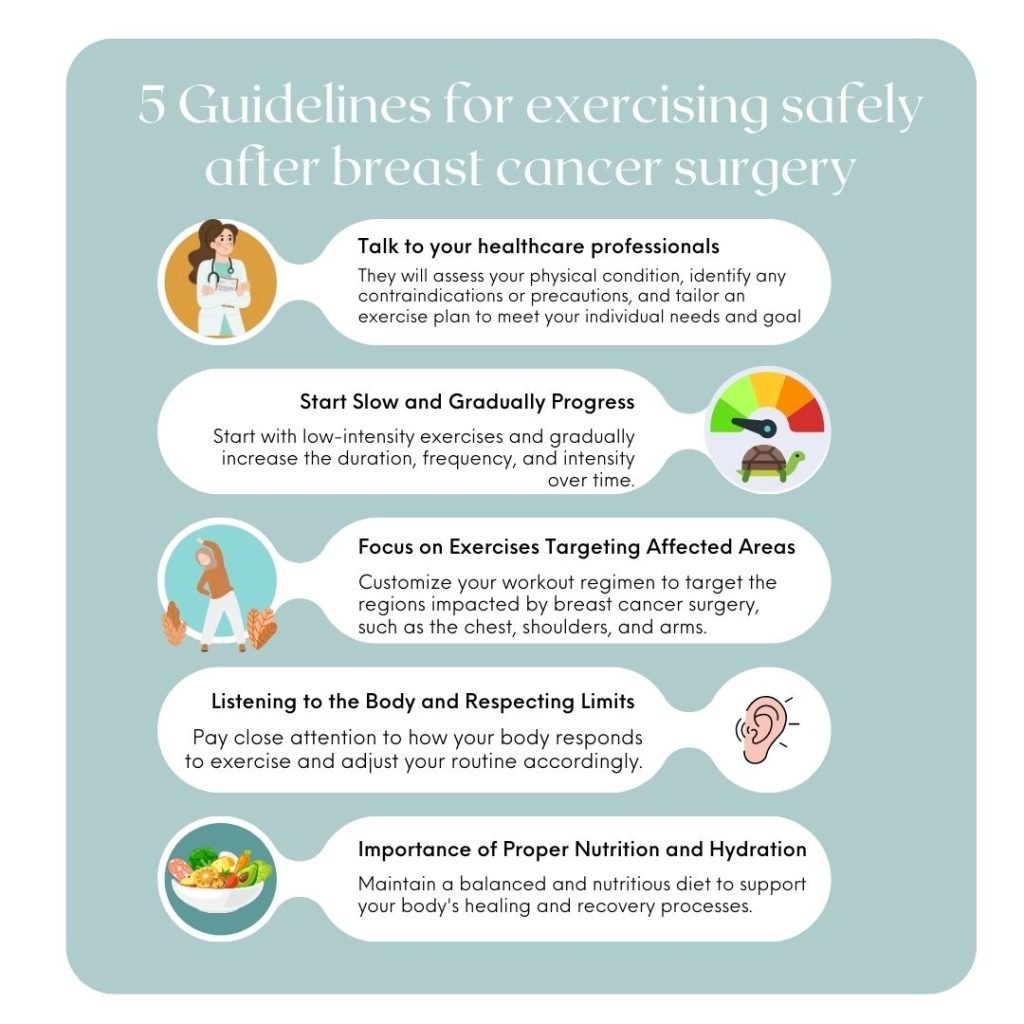No products in the basket.
Explore How Cancer Affects Relationships, And Learn Practical Strategies For Strengthening Emotional Bonds Through Communication, Compassion, And Support.
Breast cancer surgery can lead to arm and shoulder movement difficulty. So it is important to be physically active after the surgery to improve your healing process. This can help you get back to your daily activities on time. The reasons why exercise plays a crucial role in post-operative recovery are discussed in another article. In this article, we focus on the guidelines and the type of exercise that you can do after mastectomy or breast reconstruction and other breast surgeries.
By adhering to these comprehensive guidelines for exercising safely after breast cancer surgery, you can significantly enhance your chances of experiencing a smooth and successful recovery journey. By incorporating appropriate exercise strategies tailored to your unique needs and circumstances, you not only promote physical healing but also minimize the risk of complications and optimize your overall health and well-being.
Prior to initiating any exercise program, it’s imperative to consult with healthcare professionals, including your surgeon, oncologist, and physical therapist. They can provide personalized recommendations based on your specific medical history, type of surgery, and current health status. They will assess your physical condition, identify any contraindications or precautions, and tailor an exercise plan to meet your individual needs and goals. This is a good time for you to discuss any concerns or questions you may have regarding exercise, including potential risks, safety precautions, and appropriate exercise modalities.
After receiving clearance from your healthcare team, start with low-intensity exercises and gradually increase the duration, frequency, and intensity over time. Begin with gentle movements such as walking, stretching, and range of motion exercises to gradually build strength, flexibility, and endurance. Listen to your body’s signals and avoid pushing yourself too hard or too fast, especially during the initial stages of recovery. Pay attention to any signs of fatigue, discomfort, or pain, and adjust your exercise intensity accordingly.
Customize your workout regimen to target the regions impacted by breast cancer surgery, such as the chest, shoulders, and arms. Integrate specialized exercises aimed at enhancing shoulder flexibility, arm muscle strength, and lymphatic flow. These exercises might encompass shoulder rotations, wall climbs, arm rotations, and mild stretching routines. Collaborate with a physical therapist or accredited fitness professional to devise a holistic rehabilitation plan tailored to your individual requirements and constraints.
It is essential to be attentive to your body’s reactions during exercise and modify your routine accordingly. If you encounter any pain, discomfort, or unfamiliar symptoms, it is crucial to halt exercising and seek guidance from your healthcare provider promptly. Respect the boundaries of your body and refrain from pushing beyond your limits or ignoring signs of discomfort. Allow sufficient time for rest and recovery between workout sessions to prevent exhaustion and facilitate optimal healing. Stay vigilant for potential indications of lymphedema, such as swelling, sensations of heaviness, or tightness in the affected arm or hand. Refrain from engaging in activities that may exacerbate lymphatic congestion, such as lifting heavy objects or repetitive arm movements, to safeguard against complications and support your recovery process.
Listening to your body and respecting its limits is paramount when engaging in physical activity. Pay close attention to the signals your body sends during exercise, such as discomfort, fatigue, or changes in breathing. If you experience any pain or unusual sensations, it’s essential to pause and assess the situation. Pushing through pain can lead to injury or exacerbate existing conditions. Instead, honor your body’s cues by modifying your activity level or taking a break when needed. Recognize that rest and recovery are integral parts of any fitness routine, allowing your body to recuperate and adapt to the demands placed upon it. By tuning into your body’s needs and heeding its warnings, you can maintain a safe and sustainable approach to exercise, promoting overall well-being and long-term health.

By incorporating these diverse exercises into your recovery regimen, you can promote overall physical fitness, enhance range of motion and flexibility, build strength and endurance, and support your body’s healing process after breast cancer surgery. As always, consult with your healthcare provider before starting any new exercise program, and listen to your body’s signals to ensure safe and effective participation.
Addressing exercise concerns and precautions after breast cancer surgery is paramount for promoting safe and effective rehabilitation. Scar tissue formation, a natural part of the healing process, can potentially impede movement and cause discomfort. Therefore, integrating gentle massage techniques using moisturizing creams or oils can aid in enhancing tissue flexibility and circulation. Additionally, incorporating scar mobilization exercises, such as gentle stretching and rolling motions, helps break up adhesions and improve scar pliability. It’s crucial to steer clear of direct sunlight exposure to the surgical site, as UV radiation may exacerbate scarring and pigmentation changes. Seeking guidance from a physical therapist or scar management specialist can offer invaluable insights into tailored scar tissue mobilization techniques and interventions, ensuring a gradual and safe return to physical activity.
Managing pain during exercise is vital for optimizing recovery. Pain levels post-surgery can vary, and it’s essential to address them appropriately to avoid exacerbating discomfort. Over-the-counter pain medications, such as acetaminophen or nonsteroidal anti-inflammatory drugs (NSAIDs), can be utilized under healthcare provider guidance to alleviate mild to moderate pain. Complementary pain management strategies, including ice packs, heat therapy, relaxation techniques, and guided imagery, can also provide relief during exercise sessions. Engaging in low-impact exercises and movement therapies, like yoga, tai chi, or physical therapy, facilitates muscle relaxation, enhances circulation, and supports pain relief. Promptly communicating any persistent or worsening pain to healthcare providers ensures timely intervention and optimal management of exercise-related discomfort.
Understanding exercise contraindications and precautions is crucial for mitigating potential risks and ensuring a safe exercise regimen post-surgery. Certain activities may be contraindicated or necessitate modifications based on individual factors such as surgical technique, disease stage, and overall health status. High-impact or strenuous exercises, such as heavy lifting or contact sports, should be avoided to prevent undue stress on the surgical site or compromised tissues. Similarly, caution should be exercised when performing activities involving repetitive or overhead arm movements to minimize the risk of shoulder impingement or exacerbation of existing shoulder issues. Individuals who have also undergone radiation therapy should be mindful of skin sensitivity and potential limitations on certain exercises.
Consulting with healthcare providers before initiating any new exercise program or activity is essential to ensure personalized recommendations and mitigate potential risks. Vigilance for signs of complications or adverse reactions during exercise sessions and seeking prompt medical attention when necessary are integral aspects of a comprehensive post-operative exercise plan, fostering a safe and effective recovery journey.
By addressing these common concerns and taking appropriate precautions, individuals can minimize the risk of complications, promote optimal healing, and facilitate a smoother recovery following breast cancer surgery.







There Are Three Things That You Don’t See In This Image Of Me At Buckingham Palace. The Secrets Of My Radiotherapy Cover-Up Are Revealed.
Body image really suffers from breast cancer and access to a good bra is critical for a woman to revive herself. The connection is intricate.
I Wanted To Share What I Learned Along The Way, So Maybe It Can Help Someone Think About Something They Haven’t Before.
Support lymphatic health during cancer recovery. Learn practical tips and expert advice from Kirsty Wales, the Award-Winning Lymphatic Drainage Therapist
Understand Lymphoedema Causes, Symptoms, Diagnosis, Treatment Options, Prevention, And Top Online Suppliers Of Lymphoedema Sleeves.
Find Out How To Support A Friend Diagnosed With Breast Cancer. Explore Practical Tips And Heartfelt Advice To Help Them Feel Loved And Supported.
If You Have A Cancer Diagnosis I Would Say Do Your Research On Treatment Options, Usually Nothing Is Very Urgent To Decide. Find Your Community Of Support And Build A Team Around You That Might Include Your Clinicians, Alternative Therapies, Chat Groups, Etc.
Discover Why Post-Surgery Bras Are Crucial After A Mastectomy, Offering Support, Reducing Swelling, And Aiding Recovery. Find The Right Fit For Comfort And Healing.
Your donation will be used to help us with our mission, this includes providing free cancer care packages to those who need them.